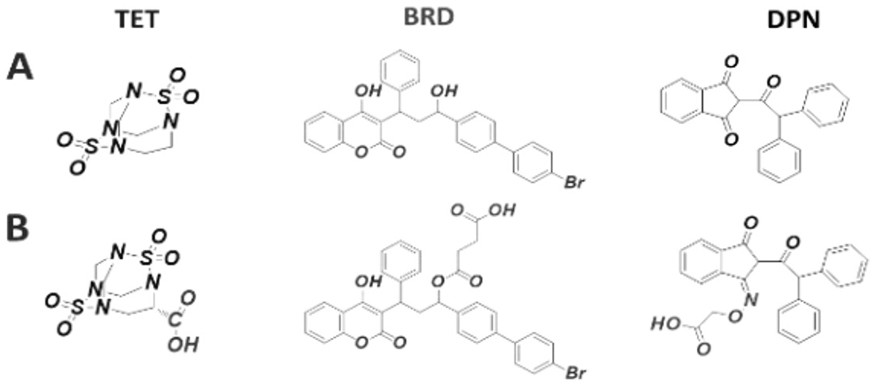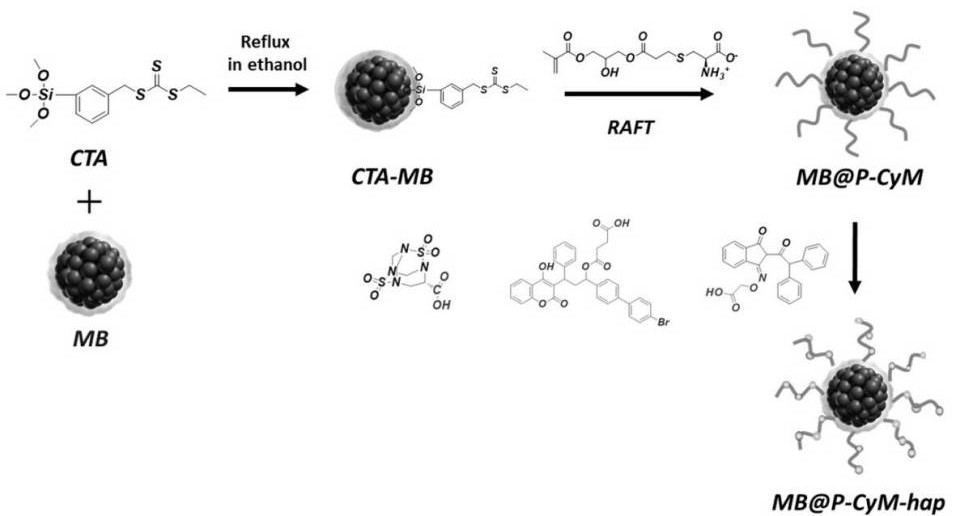A SERS system for the simultaneous detection of multiple toxic substances
A technology of toxic substances and substances, which is applied in the field of SERS system, can solve the problems of full quantity, reliability, sensitivity and repeatability, which affect the detection accuracy, and the simultaneous on-site rapid detection method of multiple targets has not been reported, and achieves good results. Effect of extension potential, low cost, enhanced combining ability
- Summary
- Abstract
- Description
- Claims
- Application Information
AI Technical Summary
Problems solved by technology
Method used
Image
Examples
preparation example 1
[0074] Preparation Example 1 Chain transfer agent (CTA) trimethoxysilane trithiocarbonate
[0075] CTA according to literature (Qu, Z.; Hu, F.; Chen, K.; Duan, Z.; Gu, H.; Xu, H., J. Colloid and Interface Sci. 2013, 398, 82-87) reported method synthesis. Specifically, 1-propanethiol (6.6 mmol) was added to K 3 PO 4 (1.02 g, 6.6 mmol) in a stirred suspension of anhydrous acetone (15 mL), and stirred for about half an hour. Join CS 2 (1.1 mL, 18 mmol), the solution turned bright yellow. After stirring for another 10 min, (4-(chloromethyl)phenyl)-trimethoxysilane (1.43 mL, 6.6 mmol) was added, stirred for 13 h under a nitrogen atmosphere at room temperature, diluted with dichloromethane and filtered. After removal of the solvent from the filtrate under reduced pressure, purification by column chromatography on silica gel with a petroleum ether / ethyl acetate gradient gave a bright yellow oil, yielding the product ethyl trimethoxysilyltrithiocarbonate.
[0076] The syn...
preparation example 2MB
[0078] Preparation example 2 Preparation of MB@P-Cym, MB@P-CyM-hap and MB@hap
[0079] 1. Preparation of MB@P-Cym
[0080] Antifouling polymer brush-grafted magnetic beads (MB@P-CyM) were prepared by typical surface-initiated polymerization (Qu, Z.; Hu, F.; Chen, K.; Duan, Z.; Gu, H.; Xu, H., J. Colloid and Interface Sci. 2013, 398, 82-87.). The specific steps are: add 50 mg CTA to 100ml MBs of absolute ethanol (1.0 mg·mL -1 ) suspension, refluxed in nitrogen for 5 h, collected the obtained CTA-MBs, and washed 3 times with ethanol. CTA-MBs were suspended in ethanol for further use. CTA-MBs (0.1 g), AIBN (20 mg), and cysteine methacrylate (CyM, 0.1 g) were dispersed in 10 mL of degassed water / methanol (1:1) solution for grafting CyM polymers brush. After bubbling nitrogen for 30 min, the system was closed and heated at 80°C. After 5 h of reaction, MB@P-CyM was collected and washed 3 times with DMF.
[0081] 2. Preparation of MB@P-CyM-hap
[0082] The triple hapt...
preparation example 3
[0092] Preparation example 3 Preparation of gold nanoflowers (AuNFs)
[0093] Prepared by hydrazine reduction method, specifically 2.0 mL of 50.0 mM HAuCl 4 Mix with 0.5 mL of 10.0 mM TA ethanol solution in 100 mL of deionized water. After stirring for 5 min, add 0.5 mL of fresh N 2 h 4 Quickly inject into solution. The color of the solution immediately changed to blue, indicating the formation of AuNFs. After standing at room temperature for 2 h, AuNFs were purified by ultracentrifugation (8 000 rpm, 5 min), washed twice with water, and finally dispersed in 10 mL of deionized water.
[0094] Figure 7 A is the TEM figure of the AuNFs obtained in Preparation Example 2, Figure 7 B is a TEM image of the AuNFs@PEG-mAb mixture obtained in Preparation Example 3. It can be seen that AuNFs are monodisperse with a size of 40–70 nm; while AuNFs@PEG-mAb can see a light-colored organic coating around gold nanoflowers (AuNFs). PEG can effectively enhance the stability of these...
PUM
| Property | Measurement | Unit |
|---|---|---|
| thickness | aaaaa | aaaaa |
| size | aaaaa | aaaaa |
| thickness | aaaaa | aaaaa |
Abstract
Description
Claims
Application Information
 Login to View More
Login to View More - R&D
- Intellectual Property
- Life Sciences
- Materials
- Tech Scout
- Unparalleled Data Quality
- Higher Quality Content
- 60% Fewer Hallucinations
Browse by: Latest US Patents, China's latest patents, Technical Efficacy Thesaurus, Application Domain, Technology Topic, Popular Technical Reports.
© 2025 PatSnap. All rights reserved.Legal|Privacy policy|Modern Slavery Act Transparency Statement|Sitemap|About US| Contact US: help@patsnap.com



